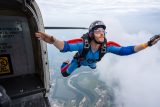How To Become A Wingsuit Skydiver
Experienced
Posted by: Start Skydiving
1 year ago
Do you longingly gaze at birds playing follow-the-leader in a formation high above? Do you want to join them in the boundless expanse of blue sky? Then this guide on how to get into wingsuiting is for you!
But first things first…
What Is Wingsuit Flying?
Wingsuit flying, also called “wingsuiting” by the professionals and a “flying squirrel suit” by non-skydivers, is when the principles of skydiving are combined with the gravity-defying aerodynamics of a wingsuit.
What is a wingsuit? A wingsuit is a glorified jumpsuit that mimics the body of a squirrel – hence, the common reference. Stand up a smidge wider than shoulder length and spread your arms all the way out. Now, imagine a piece of fabric connecting your extended hands to your hips or ankles, and another piece connecting your feet to one another. Now hold that position and jump out of an airplane!
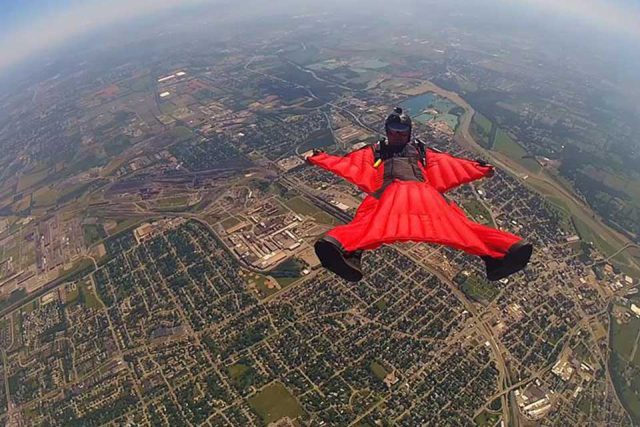
7 Steps To Learning To Wingsuit
Wingsuit training is not the first step in a jumping journey! There’s a process, and you have to start at square one like everyone else.
1. Do A Tandem Skydive
A tandem skydive is the initial step for any skydiver, regardless of which discipline you decide to get into. Tandem skydiving is when a complete novice is securely harnessed to a professional skydiving instructor. This way, people can experience the freedom of body flight with minimal day-of training.

2. Get Your Skydiving License
There are four USPA skydiving licenses, A through D. The A-license is earned by completing necessary skills in freefall and under canopy, proving sufficiency in packing a parachute, passing examinations, being an aware skydiver, and reaching 25 jumps (woo)!
More skills are required with each license, and becoming savvy in each of them is super rewarding. Throughout the progression, skydivers are able to begin to explore different disciplines, like learning to wingsuit, free-flying, or canopy piloting!
A common misconception is that wingsuiters can fly softly to the ground without a parachute – FALSE! Lucky for you, we are home to the best skydiving team in the nation, Team Fastrax, and they regularly offer free coaching and load organizing to help you hone your skills.
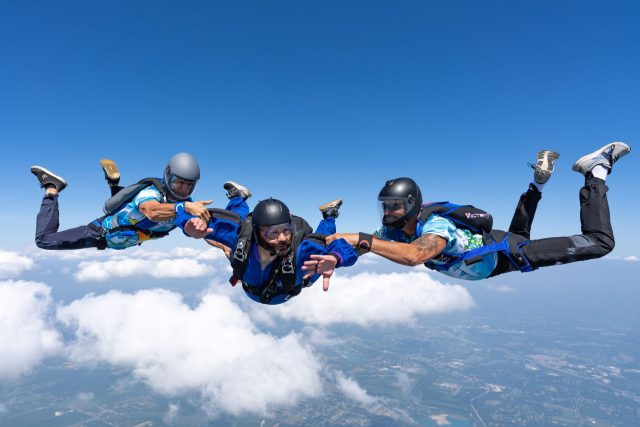
3. Become A Master Tracker
The first-taught body position in skydiving is the arch. This belly-to-earth position puts the jumper’s center of gravity (their hips) most toward the earth, keeping them stable in freefall.
How does this pertain to tracking and why is it important to learn? Well, it’s basically the opposite of arching. Essentially, it’s de-arching. Tracking allows our bodies to zoom across the sky and create horizontal separation from other jumpers. At the end of the freefall portion of a skydive, each jumper will turn away from the center of the formation and initiate a track – this ensures a proper amount of separation prior to deploying their parachutes, which acts as a preventative measure against canopy collisions or entanglements.
On a very basic level, wingsuiters are tracking with a bunch of extra fabric.
Another skill that is beneficial to get the hang of before slapping on a wingsuit: Angle flying. “Angles” are when the skydiver’s body position is a perfect combination of vertical (head down) and tracking (forward movement). Angle flyers move dynamically and create mind-blowing and visually striking formations.
Why do these both matter? Both tracking and angle-flying teach to fly safely in groups, follow a designated leader, and fly in the correct direction: toward a predetermined heading.
What is a glide ratio? Don’t worry, we’ll keep the physics lesson short! The wingsuit glide ratio, the ratio of horizontal distance compared to vertical distance, or altitude loss, is typically around 2:1 to 4:1. These ratios vary based on the type of wingsuit, the skill of the pilot, and environmental factors, such as wind speed and direction.
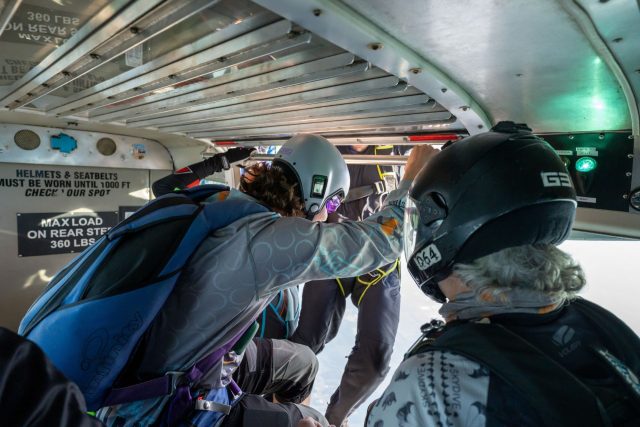
4. Build Jump Numbers (And Stay Current!)
You can’t do any wingsuit skydiving until you’ve reached 200 jumps. Why? Safety! Skydivers pride themselves in putting safety before anything else in everything they do. Two hundred sounds like a lot, but time soars by when you’re having the time of your life.
“Staying current” refers to how often you jump. There’s a difference in mentality between someone who jumps once every month and someone who jumps 20 times per month. Currency allows us to be heads up skydivers by keeping our skills up to par and not succumbing to complacency!
Big skydiving tip: Jump with people who are better than you! Coaches, instructors, jumpers qualified and skilled in the discipline you love – jump with them! Although it can be hard to put yourself in a position to be the little guy, the benefits outweigh that tenfold.
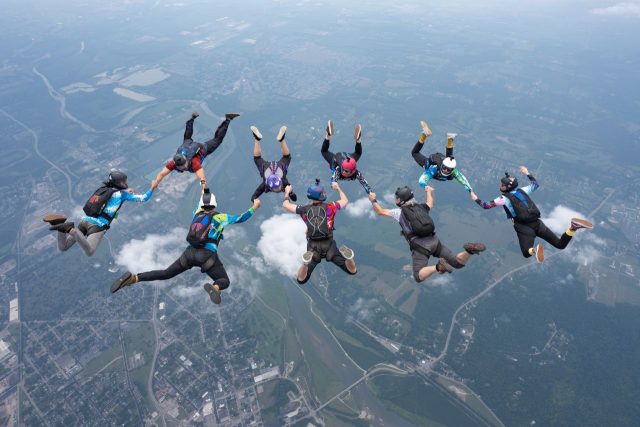
5. Do A First Jump Course (Again)
Some dropzones offer a wingsuit First Flight Course (FFC), and it’s wayyyy different than the First Jump Course you do as a baby bird student. FFC’s teach you the ins and outs of flying your suit and what differences to expect from regular skydiving – especially when it comes to safety measures.
What are the pre-reqs to start wingsuit training? An absolute minimum of 200 jumps in the last 18 months, an AAD and an altimeter, and a canopy that pairs well with a wingsuit.
6. Invest In A Suit!
If you fall in love with wingsuiting as passionately as you did skydiving, you’ll need to invest in a suit – woohoo! Just like skydiving, wingsuiting has various disciplines: racing, XRW, and acrobatics. Each one calls for specific wingsuit technology behind the suits.
It’s super common to get a used beginner suit, or rent for a while until you figure out exactly what you need!
7. Full Send
COME SEND IT! We are the proud home of full-faceted skydivers who are passionate about empowering others in the sport. Regardless of where you are in your wingsuiting journey, we assure you you’ll have plenty of people to flock with – we all started somewhere!
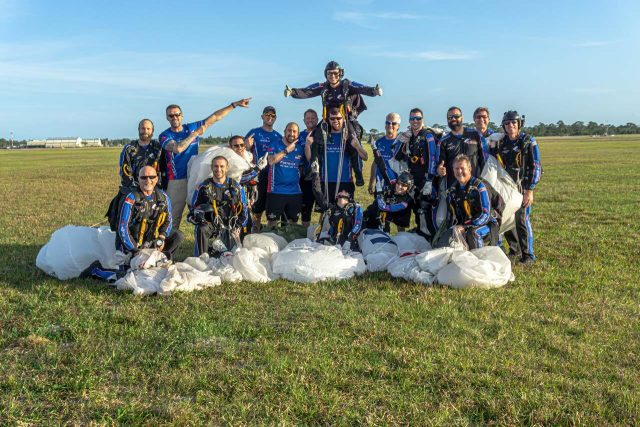
What About Wingsuit BASE Jumping?
Eeeek okay, let’s get into it! We’ve all seen the insane Red Bull videos of pilots crushing limits and zooming past picturesque (and jagged) mountain sides. Can you get to this level? What about regular wingsuit BASE jumping? Jumping from an inanimate object, like a Building, Antenna, Span, or the Earth, carries an exponential amount of risk, and it is unbelievably sick when pulled off. Is it worth the risk? Well, that’s up to the jumper.
Ready to create your own “V” formation like the birds? Jumpstart your wingsuit journey and book your tandem or start learning how to skydive today! Blue skies.
